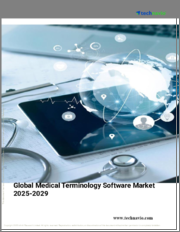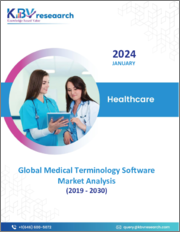
|
시장보고서
상품코드
1638848
의학용어 소프트웨어 시장 : 기회, 성장 촉진요인, 산업 동향 분석, 예측(2024-2032년)Medical Terminology Software Market Opportunity, Growth Drivers, Industry Trend Analysis, and Forecast 2024 - 2032 |
||||||
세계 의학용어 소프트웨어 시장은 2023년에 12억 달러로 평가되었으며 2024년부터 2032년에 걸쳐 14.7%의 연평균 복합 성장률(CAGR)로 견조하게 성장할 것으로 예측되고 있습니다.
이러한 성장은 심혈관 질환, 당뇨병, 호흡기 질환과 같은 비감염성 질환(NCDs)의 유병률 증가와 건강 관리 시스템의 상호 운용성에 대한 수요 증가를 기여합니다. 정확한 데이터 관리와 표준화된 의학용어의 필요성으로 의료 서비스 제공업체는 의학용어 소프트웨어를 채택하여 임상 문서 강화, 코딩 정확성 보장, 케어 팀 간의 커뮤니케이션 향상을 도모하고 있습니다.
시장은 유형별로 플랫폼과 서비스로 분류되며, 2023년에는 플랫폼 분야가 6억 7,180만 달러의 수익을 올리고 우위를 차지했습니다. 플랫폼은 전자 의료기기(EHR), 임상 의사결정 도구, 품질 보고, 진료 보상 시스템 등 건강 관리에 필수적인 용도 간의 원활한 데이터 통합을 지원합니다. 그 확장성은 헬스케어 조직이 진화하는 업무 요구에 맞추어 소프트웨어를 적응·확장할 수 있도록 하여 성장하는 의료기관에 있어서 매력적인 솔루션이 되고 있습니다. 또한 플랫폼 아키텍처는 지속적인 업데이트를 지원하고 최신 의학용어 표준과의 호환성을 보장하므로 채택이 더욱 촉진됩니다.
용도별로 볼 때 시장은 품질보고, 데이터 집계, 상환, 임상시험, 기타 용도로 나뉩니다. 품질보고는 크게 성장했으며 2032년 시장 규모는 13억 달러에 달할 것으로 예측됩니다. 이러한 성장은 규제 요건을 충족하고 재정적 인센티브를 확보하는데 있어서 품질보고가 중요한 역할을 한다는 것을 반영합니다. 정확하고 효율적인 보고서는 조직이 규정을 준수하는 데 도움이 될뿐만 아니라 환자의 치료 결과를 향상시킵니다. 의학용어 소프트웨어는 정확한 데이터 획득을 용이하게 하고, 케어 프로세스에 대한 귀중한 통찰력을 제공하고, 조직이 건강의 질 향상에 임하는 자세를 보여주는 데 도움이 됩니다.
| 시장 범위 | |
|---|---|
| 시작 연도 | 2023년 |
| 예측 연도 | 2024-2032년 |
| 시작 금액 | 12억 달러 |
| 예측 금액 | 41억 달러 |
| CAGR | 14.7% |
미국은 북미 시장을 선도하고 있고 2023년 매출은 4억 3,220만 달러였으며 2032년에는 14억 달러에 이를 것으로 예측됩니다. EHR 시스템의 통합과 데이터의 통일성 확보에 중점을 두고 있다는 것은 이 나라의 의학용어 소프트웨어의 채용을 촉진하고 있습니다. 엄격한 규제로 데이터의 정확성과 보안이 향상되고, 의료 서비스 제공업체가 이러한 솔루션을 도입하는 경향이 더욱 강해지고 있습니다. 오류를 최소화하고 보고 및 진료 보상 프로세스를 간소화함으로써, 이 소프트웨어는 미국 내외의 건강 관리 업무를 현대화하는 데 필수적인 도구가 되었습니다.
목차
제1장 조사 방법과 조사 범위
제2장 주요 요약
제3장 업계 인사이트
- 생태계 분석
- 업계에 미치는 영향요인
- 성장 촉진요인
- 비전염성 질환의 유병률 상승
- 의료 실수 감소에 대한 수요 증가
- 전자 차트(EHR)의 채용 확대
- 상호 운용성에 대한 요구 증가
- 업계의 잠재적 위험 및 과제
- 데이터 프라이버시 및 보안에 대한 우려
- 도입과 유지 보수에 따른 높은 비용
- 성장 촉진요인
- 성장 가능성 분석
- 규제 상황
- 기술적 전망
- 갭 분석
- 향후 시장 동향
- 스타트업 시나리오
- Porter's Five Forces 분석
- PESTEL 분석
제4장 경쟁 구도
- 소개
- 기업 점유율 분석
- 기업 매트릭스 분석
- 주요 시장 기업의 경쟁 분석
- 경쟁 포지셔닝 매트릭스
- 전략 대시보드
제5장 시장 추계·예측 : 유형별(2021-2032년)
- 주요 동향
- 플랫폼
- 서비스
제6장 시장 추계·예측 : 용도별(2021-2032년)
- 주요 동향
- 품질 보고
- 환급
- 데이터 집계
- 임상시험
- 기타 애플리케이션
제7장 시장 추계·예측 : 최종 용도별(2021-2032년)
- 주요 동향
- 의료 제공자
- 헬스케어 서비스 제공업체
- 의료 정보 교환 기관
- 헬스케어 IT 벤더
- 헬스케어 지불자
- 민간 지불자
- 공적 지불자
- 기타 최종 사용자
제8장 시장 추계·예측 : 지역별(2021-2032년)
- 주요 동향
- 북미
- 미국
- 캐나다
- 유럽
- 독일
- 영국
- 프랑스
- 이탈리아
- 스페인
- 네덜란드
- 아시아태평양
- 중국
- 일본
- 인도
- 호주
- 한국
- 라틴아메리카
- 브라질
- 멕시코
- 아르헨티나
- 중동 및 아프리카
- 남아프리카
- 사우디아라비아
- 아랍에미리트(UAE)
제9장 기업 프로파일
- 3M
- Apelon
- B2i Healthcare
- BiTAC
- BT Clinical Computing
- CareCom
- Cerner Corporation
- Clinical Architecture
- HiveWorx
- Intelligent Medical Objects
- Medicomp Systems
- NextGen Healthcare
- Spellex Technologies
- West Coast Informatics
- Wolters Kluwer
The Global Medical Terminology Software Market was valued at USD 1.2 billion in 2023 and is projected to grow at a robust CAGR of 14.7% from 2024 to 2032. This growth is fueled by the increasing prevalence of non-communicable diseases (NCDs), such as cardiovascular conditions, diabetes, and respiratory illnesses, as well as the rising demand for interoperability in healthcare systems. The need for precise data management and standardized medical language has driven healthcare providers to adopt medical terminology software, enhancing clinical documentation, ensuring coding accuracy, and improving communication across care teams.
The market is categorized by type into platform and services, with the platform segment dominating in 2023, generating USD 671.8 million in revenue. Platforms help in seamless data integration across essential healthcare applications, including electronic health records (EHRs), clinical decision-making tools, quality reporting, and reimbursement systems. Their scalable nature ensures that healthcare organizations can adapt and expand their software to meet evolving operational needs, making them an attractive solution for growing institutions. Additionally, the platform architecture supports continuous updates, ensuring compatibility with the latest medical terminology standards, further driving its adoption.
By application, the market is divided into quality reporting, data aggregation, reimbursement, clinical trials, and other uses. Quality reporting is set to grow significantly, with a projected market value of USD 1.3 billion by 2032. This growth reflects the critical role of quality reporting in meeting regulatory requirements and securing financial incentives. Accurate and efficient reporting not only helps organizations comply with regulations but also improves patient care outcomes. Medical terminology software facilitates precise data capture, offering valuable insights into care processes and helping organizations demonstrate their commitment to enhancing healthcare quality.
| Market Scope | |
|---|---|
| Start Year | 2023 |
| Forecast Year | 2024-2032 |
| Start Value | $1.2 Billion |
| Forecast Value | $4.1 Billion |
| CAGR | 14.7% |
U.S. leads the North American market, contributing USD 432.2 million in revenue in 2023 and is expected to reach USD 1.4 billion by 2032. The growing emphasis on integrating EHR systems and ensuring data uniformity is driving the adoption of medical terminology software in the country. Stringent regulations improve data accuracy and security, further encouraging healthcare providers to implement these solutions. By minimizing errors and streamlining reporting and reimbursement processes, this software has become a critical tool in modernizing healthcare operations in the U.S. and beyond.
Table of Contents
Chapter 1 Methodology & Scope
- 1.1 Market scope & definitions
- 1.2 Research design
- 1.2.1 Research approach
- 1.2.2 Data collection methods
- 1.3 Base estimates & calculations
- 1.3.1 Base year calculation
- 1.3.2 Key trends for market estimation
- 1.4 Forecast model
- 1.5 Primary research and validation
- 1.5.1 Primary sources
- 1.5.2 Data mining sources
Chapter 2 Executive Summary
- 2.1 Industry 360° synopsis
Chapter 3 Industry Insights
- 3.1 Industry ecosystem analysis
- 3.2 Industry impact forces
- 3.2.1 Growth drivers
- 3.2.1.1 Rising prevalence of non-communicable diseases
- 3.2.1.2 Growing demand for reducing medical errors
- 3.2.1.3 Growing adoption of electronic health records (EHRs)
- 3.2.1.4 Increasing interoperability requirements
- 3.2.2 Industry pitfalls & challenges
- 3.2.2.1 Data privacy and security concern
- 3.2.2.2 High cost associated to implementation and maintenance
- 3.2.1 Growth drivers
- 3.3 Growth potential analysis
- 3.4 Regulatory landscape
- 3.5 Technological landscape
- 3.6 Gap analysis
- 3.7 Future market trends
- 3.8 Start-up scenario
- 3.9 Porter's analysis
- 3.10 PESTEL analysis
Chapter 4 Competitive Landscape, 2023
- 4.1 Introduction
- 4.2 Company market share analysis
- 4.3 Company matrix analysis
- 4.4 Competitive analysis of major market players
- 4.5 Competitive positioning matrix
- 4.6 Strategy dashboard
Chapter 5 Market Estimates and Forecast, By Type, 2021 - 2032 ($ Mn)
- 5.1 Key trends
- 5.2 Platform
- 5.3 Services
Chapter 6 Market Estimates and Forecast, By Application, 2021 - 2032 ($ Mn)
- 6.1 Key trends
- 6.2 Quality reporting
- 6.3 Reimbursement
- 6.4 Data aggregation
- 6.5 Clinical trials
- 6.6 Other applications
Chapter 7 Market Estimates and Forecast, By End Use, 2021 - 2032 ($ Mn)
- 7.1 Key trends
- 7.2 Healthcare providers
- 7.2.1 Healthcare service providers
- 7.2.2 Health information exchanges
- 7.3 Healthcare IT vendors
- 7.4 Healthcare payers
- 7.4.1 Private payers
- 7.4.2 Public payers
- 7.5 Other end users
Chapter 8 Market Estimates and Forecast, By Region, 2021 - 2032 ($ Mn)
- 8.1 Key trends
- 8.2 North America
- 8.2.1 U.S.
- 8.2.2 Canada
- 8.3 Europe
- 8.3.1 Germany
- 8.3.2 UK
- 8.3.3 France
- 8.3.4 Italy
- 8.3.5 Spain
- 8.3.6 Netherlands
- 8.4 Asia Pacific
- 8.4.1 China
- 8.4.2 Japan
- 8.4.3 India
- 8.4.4 Australia
- 8.4.5 South Korea
- 8.5 Latin America
- 8.5.1 Brazil
- 8.5.2 Mexico
- 8.5.3 Argentina
- 8.6 Middle East and Africa
- 8.6.1 South Africa
- 8.6.2 Saudi Arabia
- 8.6.3 UAE
Chapter 9 Company Profiles
- 9.1 3M
- 9.2 Apelon
- 9.3 B2i Healthcare
- 9.4 BiTAC
- 9.5 BT Clinical Computing
- 9.6 CareCom
- 9.7 Cerner Corporation
- 9.8 Clinical Architecture
- 9.9 HiveWorx
- 9.10 Intelligent Medical Objects
- 9.11 Medicomp Systems
- 9.12 NextGen Healthcare
- 9.13 Spellex Technologies
- 9.14 West Coast Informatics
- 9.15 Wolters Kluwer



















